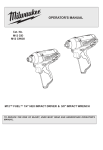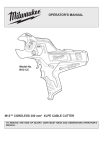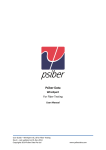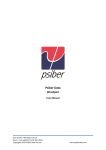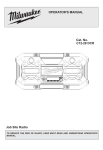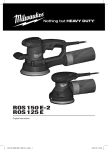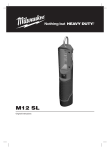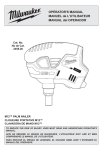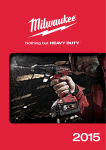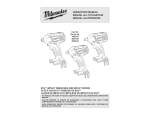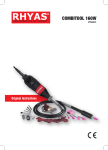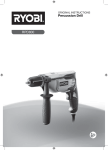Download M12CH User Manual
Transcript
OPERATOR'S MANUAL Cat. No. M12 CH SDS PLUS M12™ FUEL™ 16mm (5/8") SDS PLUS 2- MODE ROTARY HAMMER TO REDUCE THE RISK OF INJURY, USER MUST READ AND UNDERSTAND OPERATOR'S MANUAL. 2 General POWER TOOL SAFETY WARNINGS WARNING Read all safety warnings and all instructions. Failure to follow the warnings and instructions may result in electric shock, fire and/or serious injury. save all warnings and instructions for future reference. The term "power tool" in the warnings refers to your mains-operated (corded) power tool or battery-operated (cordless) power tool. attached to a rotating part of the power tool may work area SAFETY result in personal injury. •Keep work area clean and well lit. Cluttered or •Do not overreach. Keep proper footing and dark areas invite accidents. balance at all times. This enables better control •Do not operate power tools in explosive atof the power tool in unexpected situations. mospheres, such as in the presence of flam- •Dress properly. Do not wear loose clothing or mable liquids, gases or dust. Power tools create jewellery. Keep your hair, clothing and gloves sparks which may ignite the dust or fumes. away from moving parts. Loose clothes, jewel•Keep children and bystanders away while lery or long hair can be caught in moving parts. operating a power tool. Distractions can cause •If devices are provided for the connection of you to lose control. dust extraction and collection facilities, ensure these are connected and properly used. Use of electrical safety dust collection can reduce dust-related hazards. •Power tool plugs must match the outlet. Never modify the plug in any way. Do not use any POWER Tool use and care adapter plugs with earthed (grounded) power • D o not force the power tool. Use the correct tools. Unmodified plugs and matching outlets will power tool for your application. The correct reduce risk of electric shock. power tool will do the job better and safer at the •Avoid body contact with earthed or grounded rate for which it was designed. surfaces such as pipes, radiators, ranges and refrigerators. There is an increased risk of electric •Do not use the power tool if the switch does not turn it on and off. Any power tool that cannot be shock if your body is earthed or grounded. controlled with the switch is dangerous and must •Do not expose power tools to rain or wet condibe repaired. tions. Water entering a power tool will increase •Disconnect the plug from the power source the risk of electric shock. and/or the battery pack from the power tool •Do not abuse the cord. Never use the cord for before making any adjustments, changing carrying, pulling or unplugging the power tool. accessories, or storing power tools. Such Keep cord away from heat, oil, sharp edges preventive safety measures reduce the risk of or moving parts. Damaged or entangled cords starting the power tool accidentally. increase the risk of electric shock. •When operating a power tool outdoors, use an •Store idle power tools out of the reach of children and do not allow persons unfamiliar with extension cord suitable for outdoor use. Use the power tool or these instructions to operate of a cord suitable for outdoor use reduces the risk the power tool. Power tools are dangerous in the of electric shock. hands of untrained users. •If operating a power tool in a damp location is unavoidable, use a residual current device •Maintain power tools. Check for misalignment or binding of moving parts, breakage of parts (RCD) protected supply. Use of an RCD reduces and any other condition that may affect the the risk of electric shock. power tool’s operation. If damaged, have the personal safety power tool repaired before use. Many accidents are caused by poorly maintained power tools. •Stay alert, watch what you are doing and use common sense when operating a power tool. Do •Keep cutting tools sharp and clean. Properly maintained cutting tools with sharp cutting edges not use a power tool while you are tired or under are less likely to bind and are easier to control. the influence of drugs, alcohol or medication. A moment of inattention while operating power tools •Use the power tool, accessories and tool bits etc., in accordance with these instructions, may result in serious personal injury. taking into account the working conditions and •Use personal protective equipment. Always the work to be performed. Use of the power tool wear eye protection. Protective equipment such for operations different from those intended could as dust mask, non-skid safety shoes, hard hat, or result in a hazardous situation. hearing protection used for appropriate conditions will reduce personal injuries. Battery Tool use and care •Prevent unintentional starting. Ensure the switch is in the off-position before connecting •Recharge only with the charger specified by the manufacturer. A charger that is suitable for to power source and/or battery pack, picking one type of battery pack may create a risk of fire up or carrying the tool. Carrying power tools with when used with another battery pack. your finger on the switch or energising power tools •Use power tools only with specifically desigthat have the switch on invites accidents. nated battery packs. Use of any other battery •Remove any adjusting key or wrench before packs may create a risk of injury and fire. turning the power tool on. A wrench or a key left 3 •When battery pack is not in use, keep it away from other metal objects like paper clips, coins, keys, nails, screws, or other small metal objects that can make a connection from one terminal to another. Shorting the battery terminals together may cause burns or a fire. •Under abusive conditions, liquid may be ejected from the battery; avoid contact. If contact accidentally occurs, flush with water. If liquid contacts eyes, additionally seek medical help. Liquid ejected from the battery may cause irritation or burns. Symbology Volts Direct Current BPM service •Have your power tool serviced by a qualified repair person using only identical replacement parts. This will ensure that the safety of the power tool is maintained. No Load Revolutions per Minute (RPM) Blows per Minute (BPM) Underwriters Laboratories, Inc. United States and Canada SPECIFIC SAFETY RULES •Wear ear protectors. Exposure to noise can cause hearing loss. •Use auxiliary handle(s), if supplied with the tool. Loss of control can cause personal injury. •Hold power tools by insulated gripping surfaces, when performing an operation where the cutting tool may contact hidden wiring. Cutting accessory contacting a “live” wire may make exposed metal parts of the power tool “live” and could give the operator an electric shock. •Maintain labels and nameplates. These carry important information. If unreadable or missing, contact a MILWAUKEE service facility for a free replacement. •WARNING Some dust created by power sanding, sawing, grinding, drilling, and other construction activities contains chemicals known to cause cancer, birth defects or other reproductive harm. Some examples of these chemicals are: • lead from lead-based paint • crystalline silica from bricks and cement and other masonry products, and •arsenic and chromium from chemically-treated lumber. Your risk from these exposures varies, depending on how often you do this type of work. To reduce your exposure to these chemicals: work in a well ventilated area, and work with approved safety equipment, such as those dust masks that are specially designed to filter out microscopic particles. Functional Description 2 3 4 5 6 1 7 1.LED 2.SDS Plus bit holder 3.Release collar 4.Mode selector 5.Fuel gauge 6.Control switch 7.Trigger SPECIFICATIONS Cat. No. M12CH Volts DC 12 No Load RPM 0 - 900 Capacities Drill Only Rotary Hammer (concrete) Steel Wood Carbide Tipped Percussion Bit 16mm 10mm 13mm No Load Blows per Minute 0 - 6575 4 ASSEMBLY OPERATION WARNING Recharge only with the charger specified for the battery. For specific charging instructions, read the operator’s manual supplied with your charger and battery. WARNING Always remove battery pack before changing or removing accessories. Only use accessories specifically recommended for this tool. Others may be hazardous. WARNING Always remove battery pack before changing or removing accessories. Only use accessories specifically recommended for this tool. Others may be hazardous. WARNING To reduce the risk of injury, keep hands away from the bit and all moving parts. Always wear safety goggles or glasses with side shields. Inserting/Removing the Battery To remove the battery, push in the release buttons and pull the battery pack away from the tool. To insert the battery, slide the pack into the body of the tool. Make sure it latches securely into place. Fuel Gauge To determine the amount of charge left in the battery, pull the trigger. The Fuel Gauge will light up for 2-3 seconds. To signal the end of charge, 1 light on the fuel gauge will flash for 2-3 seconds. Installing Bits NOTE: Only use accessories with SDS or SDS Plus shanks. Be sure that the shank of the bit is clean. Dirt particles may cause the bit to line up improperly. Do not use bits larger than the maximum recommended capacity of the drill because gear damage or motor overloading may result. For best performance, be sure that the bit is properly sharpened and the shank is lightly greased before use. 1.Insert the bit into the nose of the tool. 2.Rotate bit slowly until it aligns with the locking mechanism. 3.Push bit into tool until it locks. 4.Check that the bit is locked properly; it should be possible to pull the bit back and forth slightly (about 6.5mm). 5.To remove bits, pull bit holder release collar toward the rear of tool and remove bit. NOTE: Use caution when handling hot bits. Selecting Action Always allow the motor to come to a complete stop before changing the mode selection to avoid damage to the tool. 1.For drilling, turn the mode selector so the arrow points to the twist drill symbol. 2.For rotary hammering, turn the mode selector so the arrow points to the hammer and twist drill symbol. NOTE: To engage the hammering mechanism, maintain pressure on the bit. When pressure on the bit is released, the hammering action will stop. Using the Control Switch The control switch may be set to three positions: forward, reverse and lock. Always allow the motor to come to a complete stop before using the control switch to avoid damage to the tool. For forward (clockwise) rotation, push in the control switch from the right side of the tool. Check the direction of rotation before use. For reverse (counterclockwise) rotation, push in the control switch from the left side of the tool. Check direction of rotation before use. To lock the trigger, push the control switch to the center position. The trigger will not work while the control switch is in the center locked position. Always lock the trigger or remove the battery pack before performing maintenance, changing accessories, storing the tool and any time the tool is not in use. 5 Starting, Stopping and Controlling Speed 1.To start the tool, grasp the handle firmly and pull the trigger. NOTE: An LED is turned on when the trigger is pulled. 2.To vary the speed, increase or decrease the pressure on the trigger. The further the trigger is pulled, the greater the speed. 3.To stop the tool, release the trigger. Make sure the tool comes to a complete stop before laying the tool down. MAINTENANCE WARNING To reduce the risk of injury, always unplug the charger and remove the battery pack from the charger or tool before performing any maintenance. Never disassemble the tool, battery pack or charger. Contact a MILWAUKEE service facility for ALL repairs. Maintaining Tool Keep your tool, battery pack and charger in good repair by adopting a regular maintenance program. After six months to one year, depending on use, return the tool, battery pack and charger to A MILWAUKEE service facility for: •Lubrication •Mechanical inspection and cleaning (gears, spindles, bearings, housing, etc.) •Electrical inspection (battery pack, charger, motor) •Testing to assure proper mechanical and electrical operation If the tool does not start or operate at full power with a fully charged battery pack, clean the contacts on the battery pack. If the tool still does not work properly, return the tool, charger and battery pack, to a MILWAUKEE service facility for repairs. Operating Position the tool, grasp the handle firmly and pull the trigger. Always hold the tool securely to maintain control. This tool has been designed to achieve top performance with only moderate pressure. Let the tool do the work. If the speed begins to drop off when drilling large or deep holes, pull the bit partially out of the hole while the tool is running to help clear dust. Do not use water to settle the dust since it will clog the bit flutes and tend to make the bit bind in the hole. If the bit should bind, stop the tool, free the bit and begin again. Applications Selecting Bits When selecting a bit, use the right type for your job. For best performance, always use sharp bits. WARNING To reduce the risk of personal injury and damage, never immerse your tool, battery pack or charger in liquid or allow a liquid to flow inside them. Drilling 1.Before drilling, be sure the workpiece is clamped securely. Use backing material to prevent damage to the workpiece during breakthrough. 2.When starting a hole, place the drill bit on the work surface and apply firm pressure. Begin drilling at a slow speed, gradually increasing the speed as you drill. 3.Always apply pressure in line with the bit. Use enough pressure to keep the drill biting, but do not push hard enough to stall the motor. 4.Reduce pressure and ease the bit through the last part of the hole. While the tool is still running, pull the bit out of the hole to prevent jamming. Cleaning Clean dust and debris from charger and tool vents. Keep tool handles clean, dry and free of oil or grease. Use only mild soap and a damp cloth to clean the tool, battery pack and charger since certain cleaning agents and solvents are harmful to plastics and other insulated parts. Some of these include gasoline, turpentine, lacquer thinner, paint thinner, chlorinated cleaning solvents, ammonia and household detergents containing ammonia. Never use Repairs For repairs, return the tool, battery pack and charger to the nearest service centre, please visit www.milwaukeetools.com.au / www.milwaukeetools.co.nz or contact our customer service centre (Australia Toll Free Telephone Number 1300 361 505) (New Zealand Toll Free Telephone Number 0800 279 624). Drilling in Wood, Composition Materials and Plastic (Use chuck adapter kit Cat. No. 48-66-1370) When drilling in wood, composition materials and plastic, start the drill slowly, gradually increasing speed as you drill. When drilling into wood, use wood augers or twist drill bits. Always use sharp bits. When using twist drill bits, pull the bit out of the hole frequently to clear chips from the bit flutes. To reduce the chance of splintering, back work with a piece of scrap wood. Use low speeds for plastics with a low melting point. 6 ACCESSORIES WARNING Always remove battery pack before changing or removing accessories. Only use accessories spec recommended for this tool. Others may be hazardous. For a complete listing of accessories refer to your Milwaukee Electric Tool catalog or go online to www.milwaukeetools.com.au / www.milwaukeetools.co.nz. To obtain a catalog, contact your local distributor or service center. Side Handle Assembly (optional) Cat. No. 201755001 7 Milwaukee Electric Tool Corporation 13135 West Lisbon Road, Brookfield, Wisconsin U.S.A. 53005 Milwaukee Electric Tool Corporation (Australia) Techtronic Industries (Australia) Pty. Ltd. Doncaster, Victoria, Australia, 3108 Milwaukee Electric Tool Corporation (New Zealand) Techtronic Industries (New Zealand) Pty. Ltd. Mangere, Auckland, New Zealand, 2022 Professionally made in China for Milwaukee Electric Tool Corporation 961011033-02(A)








